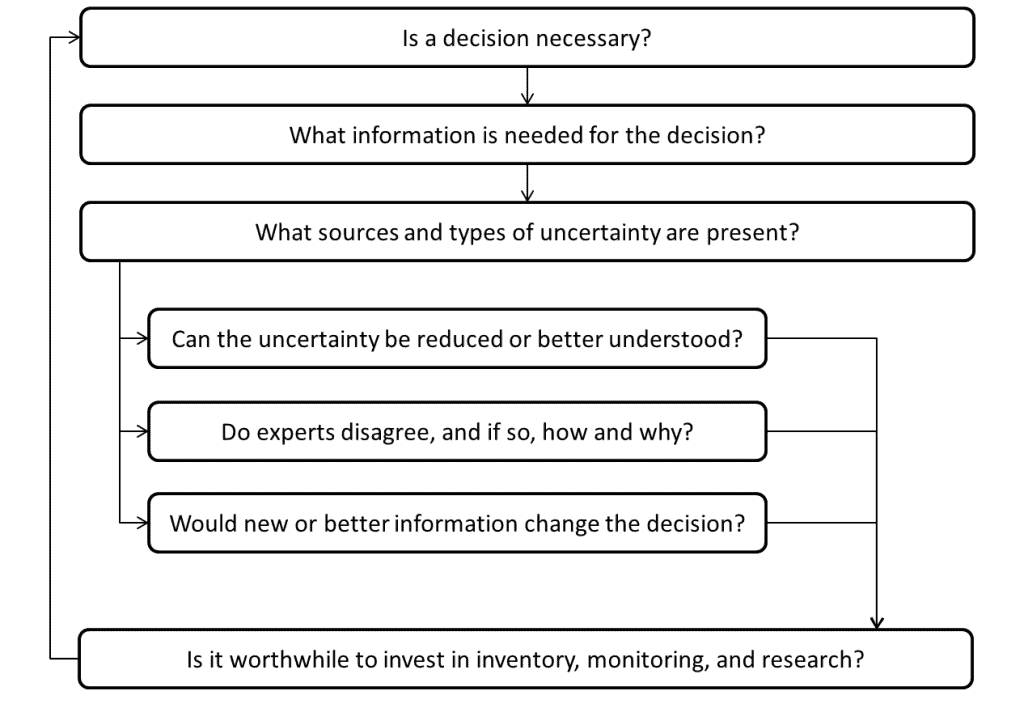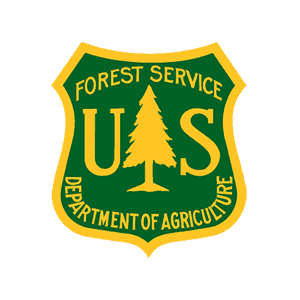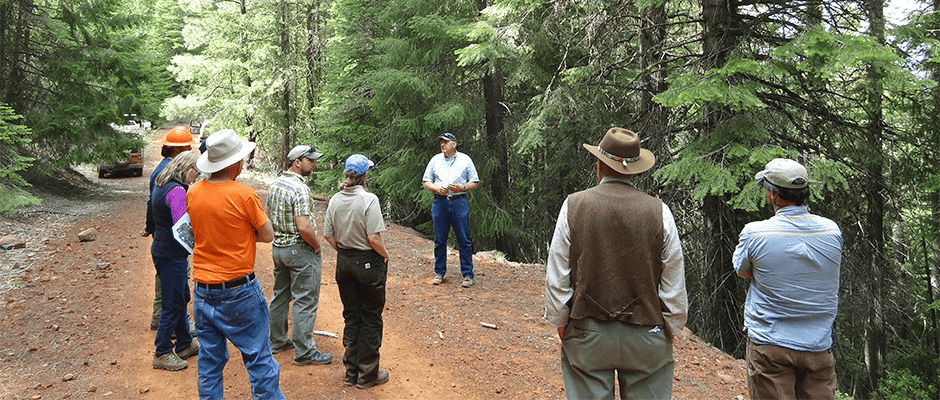Share this article
Uncertainty Is Information, Too —
from The Wildlife Professional
The Gulf Coastal Plains and Ozarks Landscape Conservation Cooperative (GCPO) faces the difficult task of designing and conserving landscapes in hardwood forests of the south-central United States. Their challenge is to devise a plan that takes into account an uncertain future of climate change and that is capable of sustaining plant and animal populations in landscapes that may look significantly different from those today. The forest’s current species are unlikely to respond similarly to a particular restoration scenario, which creates complicated tradeoffs among the responses as well as uncertainty in how individual species respond to the habitat, their own population dynamics, and changes to climate and the landscape.
Such scenarios are common in natural resource management today. No one in our profession particularly likes uncertainty, but resource management decisions of any scope and consequence invariably entail some degree of uncertainty and risk. When interpreted correctly, uncertainty itself is valuable information that helps natural resource professionals evaluate scenarios and ultimately make management decisions.
Risk in All We Do
Risk — essentially a measure of the probability and consequence of uncertain events — is an inevitable element of natural resource management. Risk analysis and risk management are integral parts of decision analysis. In classic decision theory, decisions focused on meeting stated objectives are based on articulating alternative potential actions, outcomes of those actions, probabilities of those outcomes occurring, and their costs and benefits.
Risk analysis focuses on outcomes and their associated probabilities as influenced by particular decisions, whereas risk management entails making decisions based on those probabilities and the associated costs and benefits of the outcomes.
Researchers and managers consider risks created by natural phenomena such as fires, floods and storms as well as risks or unintended consequences introduced by management actions. Applying risk management principles can help our profession grapple with problems of uncertainty and complexity and help identify which decisions are most likely to achieve the desired outcomes.
When decisions become actions, managers craft specific steps — which take into account knowns and unknowns — to implement a decision or sequence of decisions. It’s the unknowns that can provide valuable insight on which steps to take, how fast to implement actions, and what to track over time that might require redoing assessments, reevaluating decisions, and even revisiting objectives. Key questions about uncertainty should be considered throughout the risk analysis-risk management cycle.
In particular, the decision theory approach includes clearly articulating management objectives and using the best available science. It also encourages ongoing collaboration among decision-makers, analysts and stakeholders (Marcot et al. 2012b, Muro et al. 2012). A key value of this approach is identifying uncertainties such as measurement errors, system variability and knowledge gaps. It’s also useful to report how each of these sources of uncertainty influences analyses and decisions, particularly when managers must determine how well they can control specific outcomes.
Key Questions About Uncertainty in Decision Making

This flow chart shows some key questions about uncertainty in risk management. Effectively addressing uncertainty in decision making requires managers to invest considerable time and effort to understand the uncertainties they face, how those uncertainties might affect decisions and whether additional investments of resources to reduce uncertainty are warranted.
When Experts Disagree
Experts can disagree on natural resource management decisions. Rather than arming political debate, knowing what experts disagree on can be useful information for making decisions. Working with expert panels and retaining their individual responses can help researchers and managers determine how and why interpretations diverge (Gregory et al. 2012).
In addition, disagreements among experts can be used to develop competing hypotheses and predictions as well as tests of those hypotheses. This approach was used successfully to determine the potential effects of reintroducing threatened bull trout (Salvelinus confluentus) on existing threatened salmonids in northwest Oregon rivers (Marcot et al. 2012a).
Filling in the Blanks
Uncertainty itself is important information that helps decision makers determine the potential influence and value of additional information on analyses and models. In decision science, identifying and weighing the relative influence of key knowledge gaps, measurement errors, and system variability play a major role. Such influences should be ranked to help prioritize actions for inventory, monitoring and research.
But not all uncertainties need to be reduced or eliminated. In fact, some uncertainties by their very nature can’t be, and it may be surprising which uncertainties we can live with.
Your Risk Is Not My Risk
Uncertainties in natural resource risk assessments also can have different meanings depending on the setting. For example, researchers primarily consider the future viability of a population when crafting a recovery plan for a threatened species. On the other hand, land managers quite legitimately also may consider the risks of losing support from interest groups and the public as well as not meeting multiple resource objectives, reducing political capital for future conservation efforts, and so on, when applying a recovery plan.
Even when management objectives are consistent, attitudes toward risk influence decisions and implementation of recovery planning efforts. In this context, uncertainty becomes information when risk attitudes are made clear. This can be as simple as explaining what is deemed to be at risk and how objectives balance those risks.
In risk assessment, it’s helpful to depict the course of an action’s outcome in best-to worst-case scenarios (Reichert et al. 2015). Researchers and land managers may interpret those scenarios differently. This type of analysis is frequently used to identify tradeoffs such as between species conservation and recreational access; therefore, an explicit analysis of their differences is often valuable.
Another helpful exercise is depicting the most likely outcomes within the spread of outcomes. This assessment is akin to how meteorologists project potential pathways of hurricanes within a cone of uncertainty to help prepare communities that could be affected.
Uncertainty Doesn’t Always Widen Over Time
Uncertainty and risk are usually depicted as increasing as outcomes are projected further into the future. However, especially with the declining availability of natural resources, there can be greater uncertainty even in the short term. An example is projecting global oil reserves. Initially, the degree of uncertainty in multiple models is high, but models eventually converge to near zero by the middle of the next century as reserves become depleted.
Projections of the extent of Arctic sea ice in September (Collins et al. 2013) and polar bears’ population response (Amstrup et al., 2010, Atwood et al. 2015) also show this pattern in models of greenhouse gas concentration scenarios. Most scenarios project low sea-ice coverage with high certainty and adverse population outcomes by the end of the 21st century. However, the uncertainty — which depends on the extent of regional warming — is far greater over the first two to three decades.
Such predictions also have implications for anticipating the time lag of these climate effects and how soon decisions need to be made in order to avoid inevitable outcomes. Here, using uncertainty as information could help identify short-term planning and management directions that help preserve future options aimed at saving the bears from possible extinction.

Wood thrush is a focal species of the Gulf Coastal Plains and Ozarks Landscape Conservation Cooperative (hashed area of the region). Future abundance of this bird in the central hardwood forests of the United States under severe (green line) and moderate (red line) climate change scenarios are similar. However, the projections are highly uncertain, with the 80 percent confidence intervals (shaded areas) predicting a population in 2100 anywhere between half to double present day estimates.
Uncertainty Guides Monitoring and Research
One of the great values of conducting a needs assessment is that it takes stock of what is known about systems or species that may require conservation measures in the future. It also helps identify which unknowns may have the greatest influence on outcomes and the relative influence of those unknowns, which ultimately helps managers prioritize monitoring and research.
This concept is at the heart of adaptive management. A number of tools and approaches can help evaluate implications of unknowns such as analyzing the value of perfect and additional information (Maxwell et al. 2015) and using sensitivity and influence analysis models. For example, researchers (Johnson et al. 2014) analyzed the expected values of perfect and partial information to determine the best way to manage northern bobwhite quail (Colinus virginianus) in Florida. Their model included a dynamic strategy that not only improves water management but also eliminates uncertainty over population decline resulting from overharvesting and human disturbance.
Real World Examples
How the GCPO is looking at scenarios for restoring forest habitats that promote species viability provides a good example of structured decision-making. Model predictions for wood thrush (Hylocichla mustelina) in central hardwood forests do not show a clear distinction in the population’s potential responses to climate change projections. Researchers with the University of Missouri, U.S. Forest Service, the Central Hardwoods Joint Venture and the Northeast Climate Science Center have teamed up with the GCPO to combine population viability and landscape modeling with structured decision making to take into account uncertainty and reduce the complexity of forest management decisions.
The models project the impacts of climate and landscape change and habitat restoration on regional populations of focal species, while also accounting for demographic uncertainty and environmental variability. However, the considerable uncertainty surrounding the models’ projections could quickly overwhelm decision making under various conservation scenarios.
In this case, interpreting uncertainty in terms of risk provides a powerful approach to restoring the forest habitat while also promoting species viability. Uncertainty actually reflects information about viability, which can be distilled into estimates of risk. The results indicate there could be a 32 percent chance that the wood thrush population will decline by half in the next 100 years in a severe climate scenario and a 28 percent chance in a moderate one.
By simultaneously conveying responses of wildlife populations to conservation scenarios and the uncertainty in those responses, risk metrics can provide managers with a more intuitive and defensible way of comparing choices for a given species. Tradeoffs among conservation scenarios across species can be resolved by identifying scenarios that minimize the maximum risk for all, called a mini-max strategy, or maximize the minimum viability for all, called a maxi-min strategy.
The Future Is Sooner Than We Think
It is human nature to discount the future. Peoples’ attitudes toward risk can change drastically depending on what is perceived to be at risk and when the risk may occur.
Therein lies the reason for — and the bane of — adaptation planning for climate change (Lin et al. 2014). For example, the greater the uncertainty in projections of the pace and effects of rising sea levels on inundating coastal wetlands — and the further into the future such effects might occur — the less apt people may be to take immediate costly conservation actions (Quiodbach et al. 2013) such as acquiring expensive land parcels further inland for eventual marsh migration.
In other words, greater future uncertainty imparts greater present certainty in avoiding expensive activities. The longer the time frame, the greater is the propensity of people to downplay risks of failure and probabilities of future threats. This dilemma is not new in natural resource management.
So how can natural resource professionals gain approval for ecosystem restoration projects given the accelerating rate of climate change over time scales that span multiple decades, when planning cycles run only five to 15 years, elections occur every few years, and budgets cover only a single fiscal year?
The answer lies in creating formalized planning mechanisms for climate change adaptation, similar to how establishing urban growth boundaries has both constrained excessive development and allowed for future development. The challenge that we face as natural resource professionals is retaining viable options into the future for species and ecosystems given the types, degrees and perceptions of uncertainty in changing environments.
 To retain options — not just for climate change adaptation planning but for most resource management issues — means transparently identifying and evaluating uncertainties and recognizing that they can impart valuable information for resource management decisions. From a practical and policy perspective, uncertainty of future outcomes can be viewed as a welcome opportunity for meeting unforeseen changes in social needs and interests.
To retain options — not just for climate change adaptation planning but for most resource management issues — means transparently identifying and evaluating uncertainties and recognizing that they can impart valuable information for resource management decisions. From a practical and policy perspective, uncertainty of future outcomes can be viewed as a welcome opportunity for meeting unforeseen changes in social needs and interests.
Header Image: A group of researchers, scientists and managers examine forest conditions and habitat suitability. One of the uncertainties they face is how alternative fuel management practices could reduce fire risk. By looking at various scenarios and the associated uncertainty, the team can develop risk metrics to help them compare the practices under consideration.












